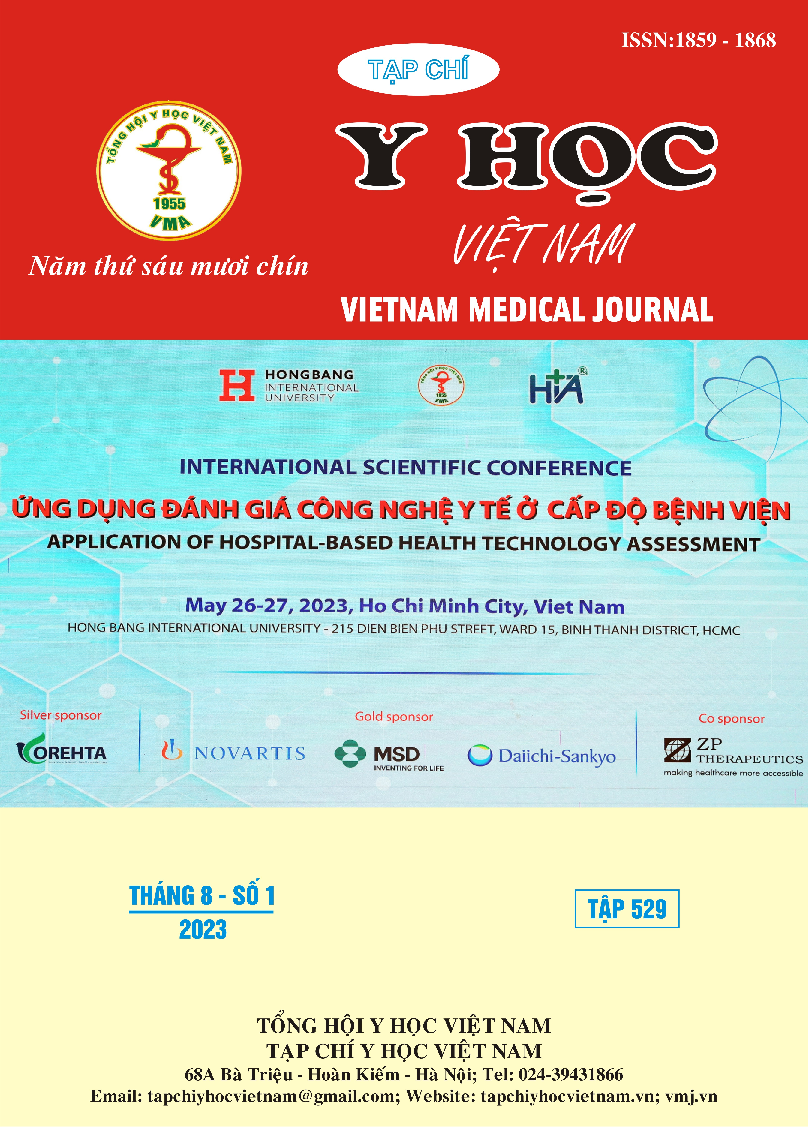GIÁ TRỊ TIÊU CHUẨN “CŨ VÀ MỚI” TRONG CHẨN ĐOÁN PHÂN BIỆT CƠN TIM NHANH PHỨC BỘ QRS GIÃN RỘNG
Nội dung chính của bài viết
Tóm tắt
Mục tiêu: So sánh độ nhạy, độ đặc hiệu, giá trị chẩn đoán âm tính, dương tính 5 tiêu chuẩn phân biệt cơ chế cơn tim nhanh QRS giãn rộng: (1) Brugada, (2) Bayesian, (3) Griffith, (4) PAVA, (5) Vereckei aVR. Đối tượng và phương pháp nghiên cứu: Phân tích hồi cứu cơn tim nhanh QRS giãn rộng được thăm dò điện sinh lý tim. So sánh giá trị các tiêu chuẩn truyền thống hoặc mới. Kết quả: 86 điện tâm đồ cơn tim nhanh: 38 cơn chẩn đoán là cơn tim nhanh thất, 48 cơn chẩn đoán là cơn tim nhanh trên thất. Áp dụng 5 tiêu chuẩn phân biệt có độ chính xác tương đương nhau (mức độ trung bình) mặc dù PAVA (DII RWPT) có độ chính xác thấp hơn lưu đồ Brugada có ý nghĩa thống kê (69,8% và 78,2%, P = 0,031). PAVA có độ nhạy (60,5%) thấp hơn lưu đồ Brugada (88,0%), Griffith (94,2%) và Bayesian (88,6%) (P < 0,001). Tiêu chuẩn Griffith có độ đặc hiệu (39,8%) thấp hơn DII RWPT (77,1%), lưu đồ Brugada (58,9%) và Bayesian (51,7%) (P < 0,05). Tỷ số khả dĩ dương PAVA, lưu đồ Brugada, Bayesian, Vereckei aVR và Griffith lần lượt là 2,64; 2,13; 1,89; 1,60 và 1,57. Kết luận: Tiêu chuẩn chẩn đoán “mới” tỏ ra không ưu thế hơn lược đồ Brugada trong phân biệt cơ chế cơn tim nhanh có phức bộ QRS rộng.
Chi tiết bài viết
Từ khóa
Nhịp nhanh thất, nhịp nhanh trên thất, cơn tim nhanh phức bộ QRS giãn rộng, lưu đồ Brugada, tiêu chuẩn PAVA.
Tài liệu tham khảo
2. Kindwall KE, Brown J, Josephson ME. Electrocardiographic criteria for ventricular tachycardia in wide complex left bundle branch block morphology tachycardias. Am J Cardiol. 1988;61(15):1279-1283. doi:10.1016/0002-9149(88)91169-1
3. Sandler IA, Marriotr HJL. The Differential Morphology of Anomalous Ventricular Complexes of RBBB-Type in Lead V1: Ventricular Ectopy versus Aberration. Circulation. 1965;31(4):551-556. doi: 10.1161/01.CIR.31.4.551
4. Brugada P, Brugada J, Mont L, Smeets J, Andries EW. A new approach to the differential diagnosis of a regular tachycardia with a wide QRS complex. Circulation. 1991;83(5):1649-1659. doi: 10.1161/01.CIR.83.5.1649
5. Griffith MJ, Mounsey P, Camm A, Garratt CJ. Ventricular tachycardia as default diagnosis in broad complex tachycardia. The Lancet. 1994;343(8894):386-388. doi:10.1016/S0140-6736(94)91223-8
6. Lau EW, Pathamanathan RK, Ng GA, Cooper J, Skehan JD, Griffith MJ. The Bayesian Approach Improves the Electrocardiographic Diagnosis of Broad Complex Tachycardia. Pacing Clin Electrophysiol. 2000;23(10):1519-1526. doi:10.1046/j.1460-9592.2000. 01519.x
7. Vereckei A, Duray G, Szénási G, Altemose GT, Miller JM. New algorithm using only lead aVR for differential diagnosis of wide QRS complex tachycardia. Heart Rhythm. 2008;5(1):89-98. doi: 10.1016/j.hrthm.2007.09.020
8. Pava LF, Perafán P, Badiel M, et al. R-wave peak time at DII: A new criterion for differentiating between wide complex QRS tachycardias. Heart Rhythm. 2010;7(7):922-926. doi: 10.1016/j.hrthm.2010.03.001
9. Lau EW, Ng GA. Comparison of the Performance of Three Diagnostic Algorithms for Regular Broad Complex Tachycardia in Practical Application. Pacing Clin Electrophysiol. 2002;25(5):822-827. doi:10.1046/j.1460-9592.2002. 00822.x
10. Vereckei A, Duray G, Szenasi G, Altemose GT, Miller JM. Application of a new algorithm in the differential diagnosis of wide QRS complex tachycardia. Eur Heart J. 2006;28(5):589-600. doi:10.1093/eurheartj/ehl473


